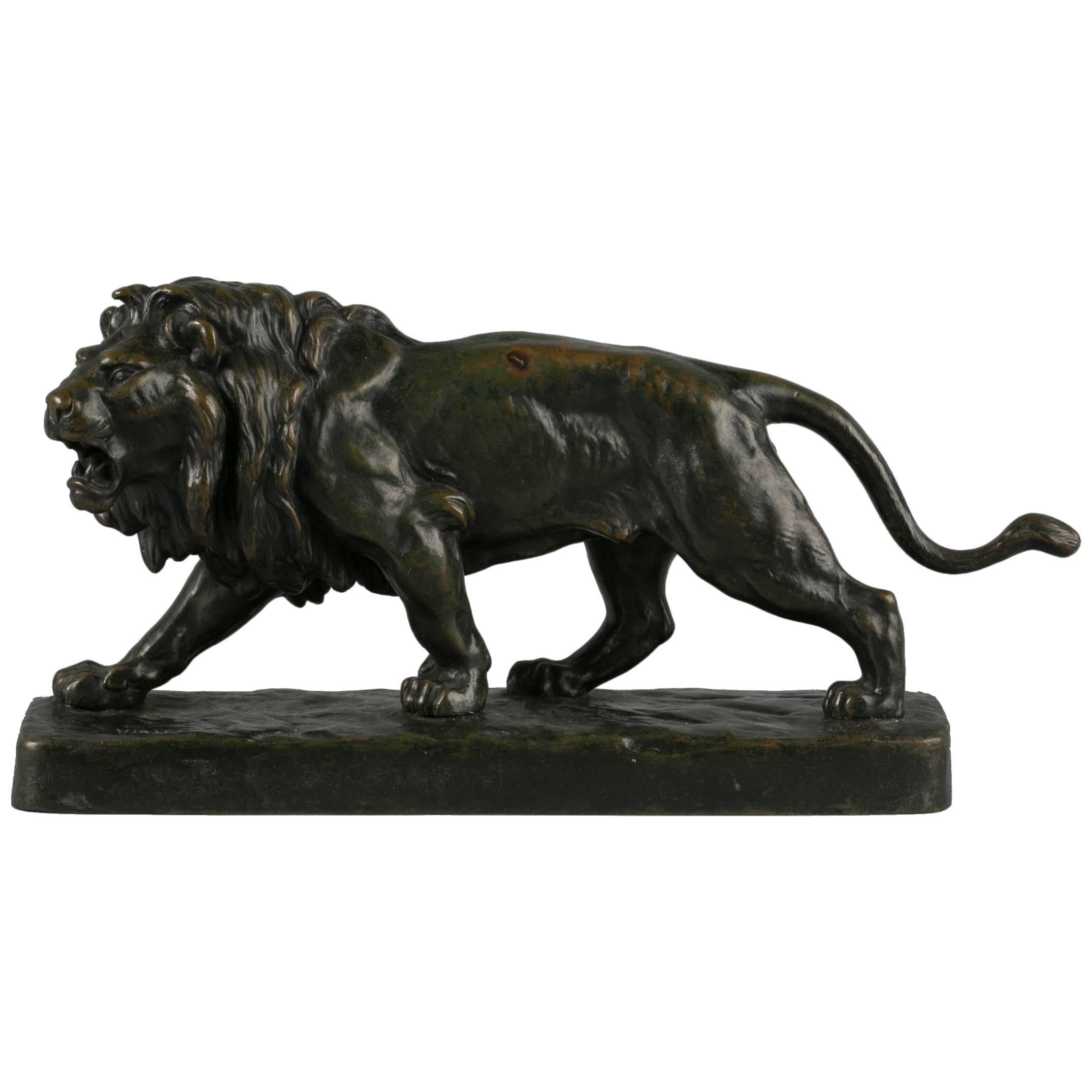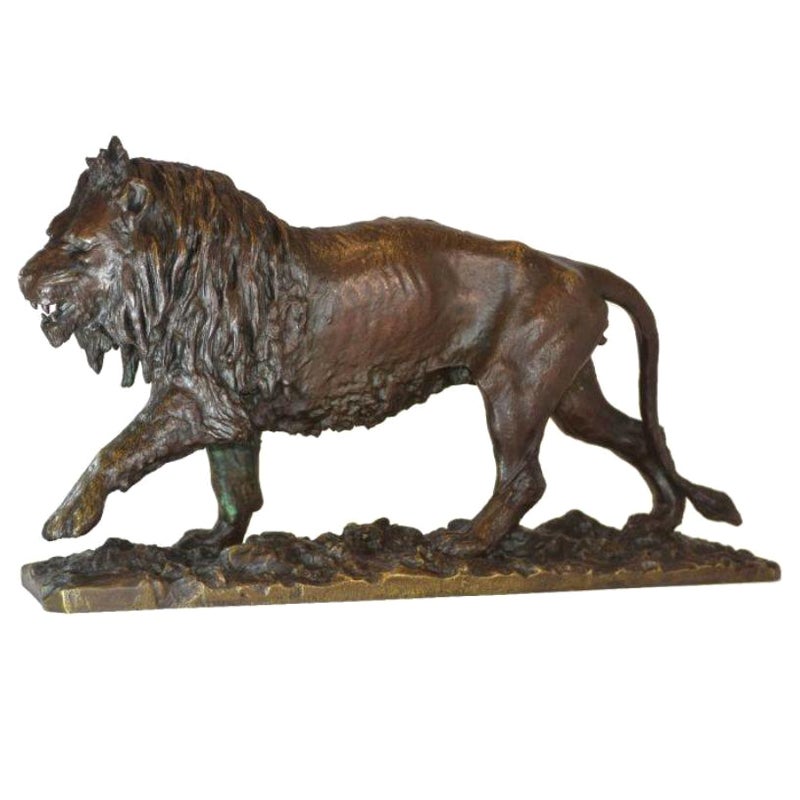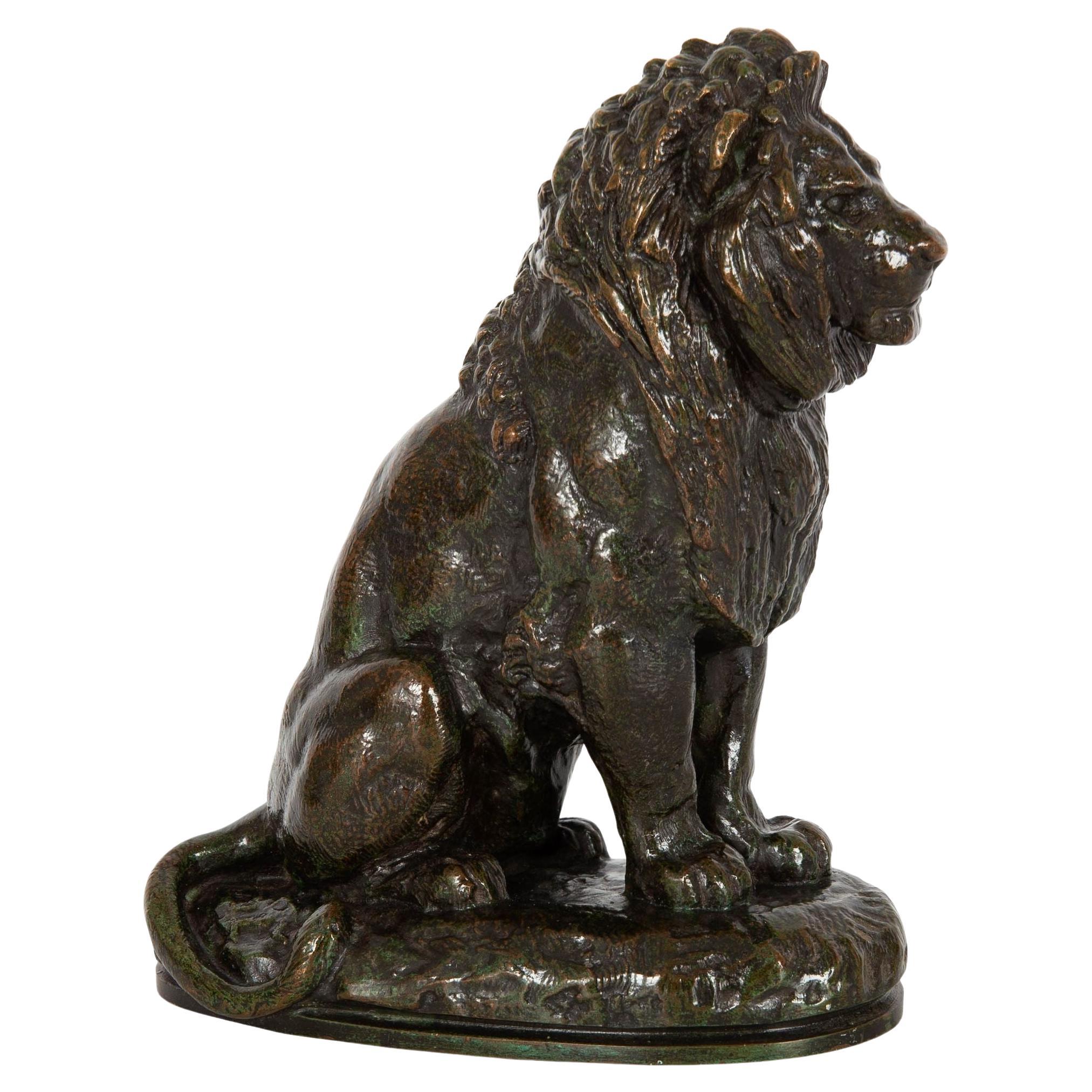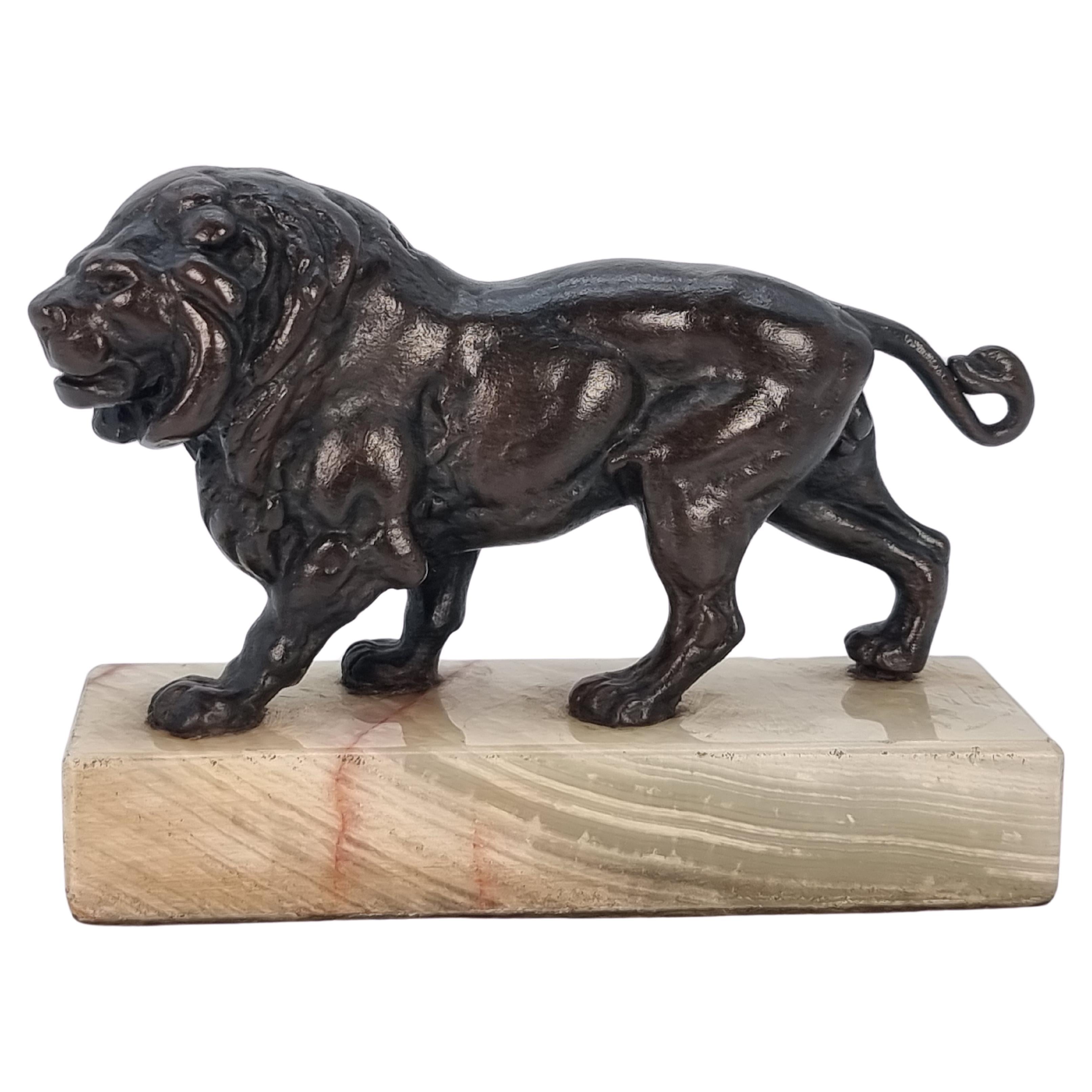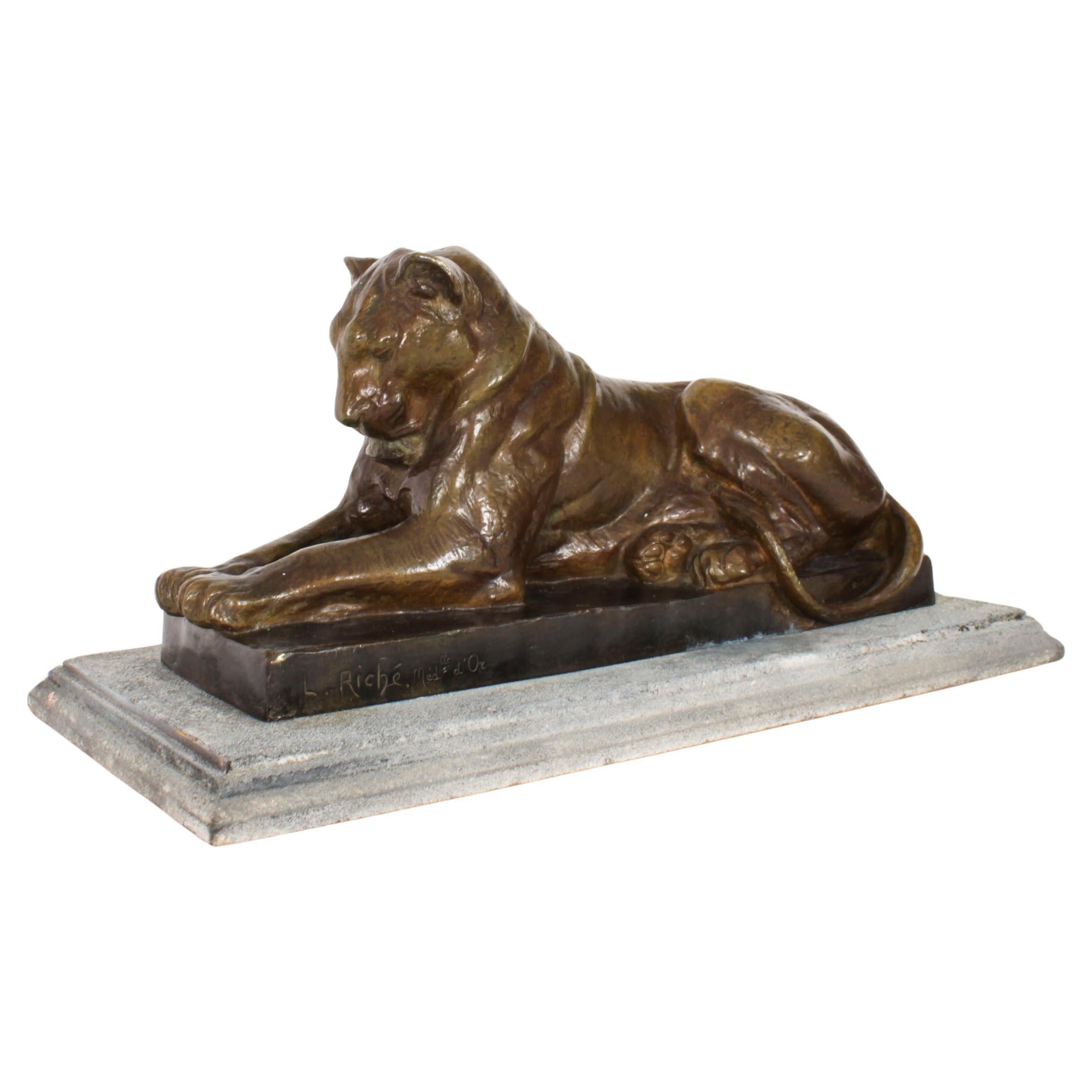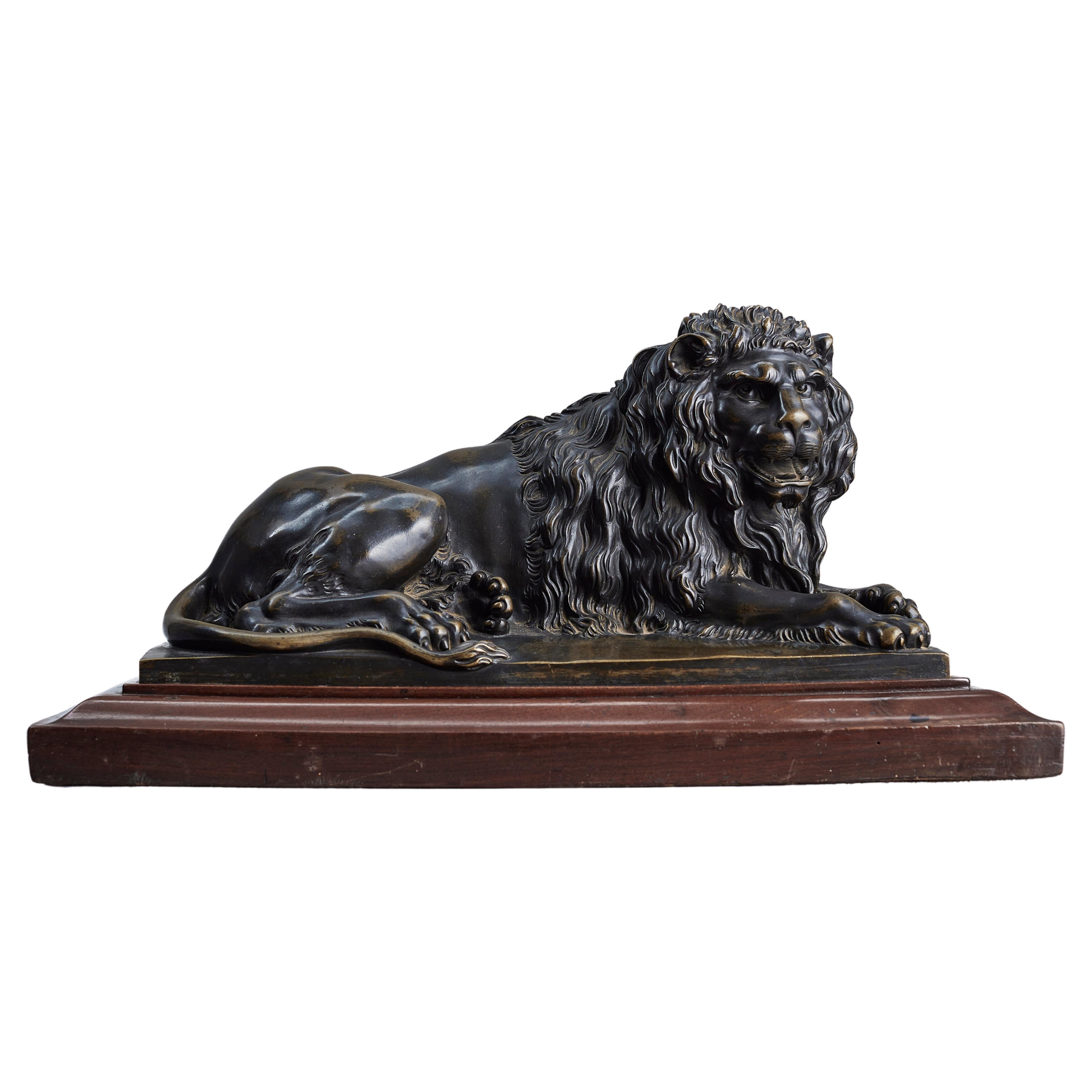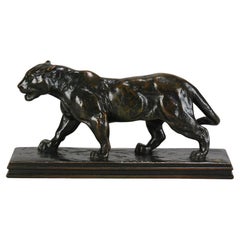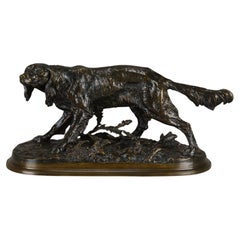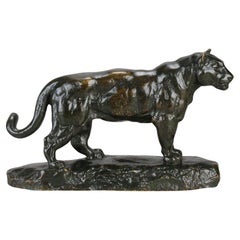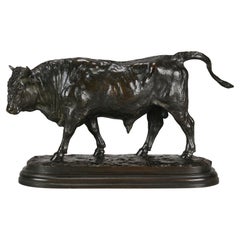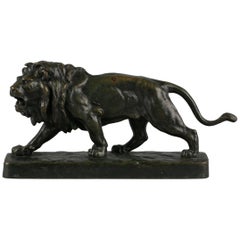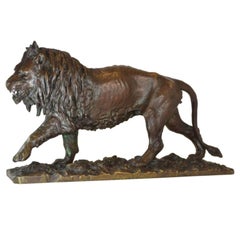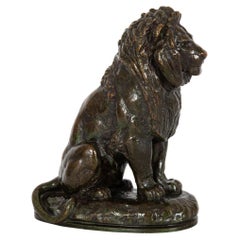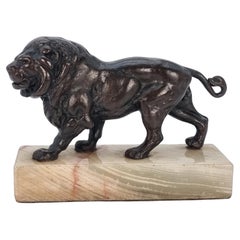Items Similar to Early 20th Century Bronze Sculpture Entitled "Lion qui Marche" by J Descomps
Want more images or videos?
Request additional images or videos from the seller
1 of 12
Early 20th Century Bronze Sculpture Entitled "Lion qui Marche" by J Descomps
$7,190.93
£5,250
€6,170.78
CA$9,928.05
A$11,006.71
CHF 5,784.46
MX$134,704.11
NOK 72,241.98
SEK 67,806.33
DKK 46,061
About the Item
A large and impressive early 20th Century bronze study of a walking lion with fine deep brown, gold and orange patination and good surface detail. Raised on naturalistic bronze base, signed Joe Descomps
Additional Information
Height: 30 cm
Width: 55 cm
Circa: 1910
Materials: Bronze
Book Ref: Art Deco & Other Figures by Bryan Catley
Page No: 134
About
Joseph Descomps
Joseph Descomps, French – 1869 to 1950 ~ Born at Clermont-Ferrand, he studied under Hiollin and exhibited figures and reliefs at the Salon des Artistes Francais of which he became a member from 1893 securing an honourable mention in 1898, a bonze medal in 1921, a silver in 1925 and gold in 1928. Descomps was elevated to the rank of Chevalier of the legion d’Honneur. Renowned for sculpting mythological and fine Art Deco streamlines figurative subjects.
The Art Deco Period: although Art Deco derives its name from the great 1925 Paris Exhibition, ‘L’Exposition Internatlionale des Arts Décoratifs et Industriels Modernes’, the term is now generally applied to the typical artistic productions of the 1920’s and 1930’s. It might best be characterised as an attempt to unite arts with industry, embracing the machine age and repudiating the old antithesis of ‘Fine’ and ‘Industrial’ art. The sources of the Art Deco movement include Egyptian and Mayan Art, Cubisim, Fauvism and Expressionism, heavily influencing the chief force underlying all Art Deco with the emphasis upon geometric patterns.
- Creator:Joe Descomps Cormier (Artist)
- Dimensions:Height: 11.82 in (30 cm)Width: 21.66 in (55 cm)Depth: 0 in (0.01 mm)
- Style:Art Nouveau (Of the Period)
- Materials and Techniques:Bronze,Cast
- Place of Origin:
- Period:1910-1919
- Date of Manufacture:1910
- Condition:Wear consistent with age and use. Excellent. Excellent Original Condition Please note that our items are genuine antiques with considerable age. It is therefore normal that they will show some signs of wear and handling to the surface.
- Seller Location:London, GB
- Reference Number:Seller: 85661stDibs: LU3216328989392
About the Seller
5.0
Vetted Professional Seller
Every seller passes strict standards for authenticity and reliability
Established in 1936
1stDibs seller since 2017
84 sales on 1stDibs
Typical response time: <1 hour
- ShippingRetrieving quote...Shipping from: London, United Kingdom
- Return Policy
Authenticity Guarantee
In the unlikely event there’s an issue with an item’s authenticity, contact us within 1 year for a full refund. DetailsMoney-Back Guarantee
If your item is not as described, is damaged in transit, or does not arrive, contact us within 7 days for a full refund. Details24-Hour Cancellation
You have a 24-hour grace period in which to reconsider your purchase, with no questions asked.Vetted Professional Sellers
Our world-class sellers must adhere to strict standards for service and quality, maintaining the integrity of our listings.Price-Match Guarantee
If you find that a seller listed the same item for a lower price elsewhere, we’ll match it.Trusted Global Delivery
Our best-in-class carrier network provides specialized shipping options worldwide, including custom delivery.More From This Seller
View AllMid 19th Century Animalier Bronze "Jaguar Qui Marche" by Antoine L Barye
By Antoine-Louis Barye
Located in London, GB
A dramatic mid 19th Century French bronze animalier study of a powerful striding jaguar with excellent autumnal (green, brown, and orange) patina and intricate hand chased surface de...
Category
Antique Mid-19th Century French Art Nouveau Animal Sculptures
Materials
Bronze
19th Century Animalier Bronze Sculpture entitled "Medor" by Pierre Jules Mene
By Pierre Jules Mêne
Located in London, GB
An excellent mid 19th Century Animalier bronze study of a setter in an alert turning pose with very fine rich brown patina and intricate hand chased surface detail, raised on natural...
Category
Antique Late 19th Century French Art Nouveau Animal Sculptures
Materials
Bronze
Mid 19th Century Animalier Bronze entitled "Jaguar Debout" by Antoine L Barye
By Antoine-Louis Barye
Located in London, GB
An impressive late 19th Century Animalier bronze study of a standing jaguar with excellent rich green patina and very fine hand chased surface detail. Raised on an integral base, sig...
Category
Antique Mid-19th Century French Art Nouveau Animal Sculptures
Materials
Bronze
19th Century Animalier French Bronze Entitled "Taureau Debout" by Rosa Bonheur
By Rosa Bonheur
Located in London, GB
"Taureau Debout" by Rosa Bonheur.
An excellent late 19th Century French animalier bronze study of a standing bull with fine hand chased surface that accentuates the muscle definition of the subject, signed Rosa B.
ADDITIONAL INFORMATION
Measures: Width: 32 cm
Height: 18 cm
Depth: 11cm
Condition: Excellent Original Condition
Circa: 1870
Materials: Bronze
Book reference: Animals in Bronze by Christopher Payne
Page no. 174
DESCRIPTION
Bonheur, Rosa (1822-1899)
The most popular artist of nineteenth-century France, Rosa Bonheur was also one of the first renowned painters of animals and the first woman awarded the Grand Cross by the French Legion of Honor. A professional artist with a successful career, Bonheur lived in two consecutive committed relationships with women.
Born on March 16, 1822 in Bordeaux, Marie Rosalie Bonheur was the oldest of the four children of Raimond Oscar Bonheur (1796-1849) and Sophie Marquis. Bonheur's father was an art teacher who came from a poor family, while her mother, a musician, had descended from a middle-class family and had been her husband's art student.
Bonheur's father, who taught drawing and landscape painting, was an ardent member of the utopian Saint Simeon society.
The group held idealistic beliefs about the reform of work, property, marriage, and the role of women in society. Most importantly, for the artist's future, the Saint Simeons questioned traditional gender norms and firmly believed in the equality of women. While teaching artistic techniques to his oldest daughter, Raimond Bonheur also encouraged her independence and taught her to consider art as a career.
In 1828 Raimond Bonheur joined the Saint Simeons at their retreat outside Paris. Sophie and the children joined him in Paris the following year. Four years later, however, Raimond abandoned his family to live in isolation with his fellow Saint Simeons.
Sophie Bonheur died in 1833 at the age of thirty-six. Rosa was only eleven years old when her mother died, but she was aware of the heavy price her mother paid for married life with a man who was more dedicated to his own ideals than to meeting his family's needs. Rosa also saw that her mother's marriage led to poverty and her death from exhaustion.
After her mother's death, Bonheur was taken in by the Micas family who resided nearby. Mme Micas and Bonheur's mother had been friends. When Mme Bonheur died, the Micas family paid Raimond Bonheur's debts and cared for Rosa. Their daughther, Nathalie, who would later become an amateur inventor and unschooled veterinarian, and Rosa became enamored with each other.
When Rosa Bonheur began her career as a professional artist, she had already been trained by her father who had allowed her to study in all male classes. Rosa also learned by sketching masterworks at the Louvre from the age of fourteen, and later, by studying with Léon Cogniet.
From the very beginning, Bonheur's favorite subject was animals. She learned their anatomy completely by dissecting them in local slaughterhouses. She also visited the horse market two times a week. Study of animals by direct observation led to the formation of the realist style in which Bonheur worked.
It was for such work that Bonheur obtained written permission from the French government to wear men's slacks. Her working attire also consisted of a loose smock and heavy boots that protected her feet from the dangerous environment in which she painted. The style of dress that the artist adopted for work and home may well have been influenced by her father's attire, which was based on St. Simeonian clothing experiments. Bonheur also cropped her hair, perhaps to facilitate her work. She did, however, always wear dresses for social occasions because she knew that appropriate dress would further her career.
Bonheur earned a successful living as a painter of animals. She exhibited at the annual Paris Salon regularly from the age of nineteen in 1841 through 1853, when she was thirty-one. She won the salon's gold medal at the age of twenty-six in 1848 and was commissioned by the French government to paint Plowing on the Nivernais in 1849. In the same year Bonheur and her sister Juliette became directors of l'École gratuite de dessin pour les jeunes filles, a post their father had once held.
Bonheur completed her most renowned work, The Horse Fair, in 1855. The successful representation of percherons (a breed native to Normandy) was purchased by Ernest Gambart, a London art dealer whose gallery specialized in work by French artists. He exhibited The Horse Fair in London where Bonheur visited with Nathalie. Queen Victoria requested a private viewing of the painting at Windsor Castle. It would later be purchased in 1887 by Cornelius Vanderbilt and donated to the new Metropolitan Museum of Art in New York City.
Bonheur's trip to England allowed her to meet Charles Eastlake, then President of the Royal Academy, John Ruskin, the English writer and critic, and Edwin Landseer, the British animalier. She also toured the English and Scottish countrysides and executed some paintings based on her observations of new breeds of animals found there.
Gambart made engravings of Bonheur's work, including The Horse Fair, and sold them in England, Europe, and the United States. Bonheur became one of the most renowned painters of the time. Little girls, such as Anna Klumpke in the United States, even had dolls in her likeness, much as American girls played with Shirley Temple dolls...
Category
Antique 19th Century French Art Nouveau Animal Sculptures
Materials
Bronze
Late 19th Century Animalier Bronze Sculpture "Cheval Arabe No.3" by Pierre Jules
By Pierre Jules Mêne
Located in London, GB
"Cheval Arabe No.3" by Pierre Jules Mene
An attractive late 19th Century Animalier bronze study of an arab stallion. The bronze exhibiting excellent hand chased surface detail and g...
Category
Antique 19th Century French Art Nouveau Animal Sculptures
Materials
Bronze
Animalier Bronze Sculpture Entitled "Bear and Rabbit" by Charles Paillet
By Charles Paillet
Located in London, GB
An amusing early 20th Century bronze group of a bear peering over the edge of a rock at a rabbit quietly hiding under a ledge, with excellent rich brown patina and fine hand chased surface detail. Signed Paillet
ADditional information
Measures: Height: 18 cm.
Condition: Excellent Original Condition.
circa: 1910.
Materials: Patinated Bronze.
ABOUT
Charles Paillet
Charles Paillet (French, 1871 ~ 1937) Paillet studied sculpture under Georges Gardet. Paillet’s first exhibit was in the Salon of 1897 and he exhibited regularly until 1921. Most of his works were cast by the foundry Thiebault Freres both in lost wax and by the sand-cast method. A few of his works have been recorded bearing the F. Barbedienne foundry mark also. Charles Paillet, Georges Gardet, Rene Paris...
Category
Early 20th Century French Art Deco Animal Sculptures
Materials
Bronze
You May Also Like
French Bronze Figure of a Striding Lion, circa 1860
Located in New York, NY
French bronze figure of a striding lion, circa 1860
Signed by Louis Vidal (1831-1892).
Category
Antique 1860s French Animal Sculptures
Materials
Bronze
19th Century Lion Animal Bronze by Fratin
By Christophe Fratin
Located in Marseille, FR
Lion animal bronze patina 19th century medallion signed Fratin on the terrace dimension 53 cm long 31 cm high 15 cm deep
Additional information:
Materi...
Category
Antique 19th Century Animal Sculptures
Materials
Bronze
Bronze Sculpture “Lion Assis No. 2”, Antoine Louis Barye, circa 1880
By Antoine-Louis Barye
Located in Shippensburg, PA
Initially modeled by Barye in 1846 as a commission by Louis-Phillipe for the Tuilleries Gardens at a cost of 10,000 francs, the life-size sculpture sat near to Barye's Lion au Serpent until it was later moved in 1867 to the grand entrance to Pavilion de Flore and a pair was crafted for it using a mechanical technique. This incensed Barye, as he insisted a mate must be sculpted to oppose Lion Assis...
Category
Antique 19th Century French Romantic Animal Sculptures
Materials
Bronze
Antique French late 19th century bronze study of a prowling lion circa 1900
Located in Central England, GB
This superbly detailed fine bronze study depicts a male prowling lion. His body ripples with his muscular physique as he moves forward on large clawed paws. His head is framed with a...
Category
Antique 1890s French Louis Philippe Animal Sculptures
Materials
Bronze
Antique French Bronze Sculpture of Lioness by Louis Riche Early 20th Century
Located in London, GB
This is a beautiful antique bronze sculpture of a lioness by the renowned French sculptor Louis Riche (1877 - 1947), circa 1910 in date.
The sculpture depicts a recumbent lioness r...
Category
Vintage 1910s Animal Sculptures
Materials
Bronze
French large Bronze of a Lion after Claude Michel Clodion, 19th century
By Claude Michel Clodion
Located in Worpswede / Bremen, DE
Very fine and large bronze of a reclining lion. Many details, such as the treatment of the lion’s mane demonstrate the sculptor’s mastery skill, as well as an understanding of the an...
Category
Antique 19th Century French Neoclassical Animal Sculptures
Materials
Bronze
